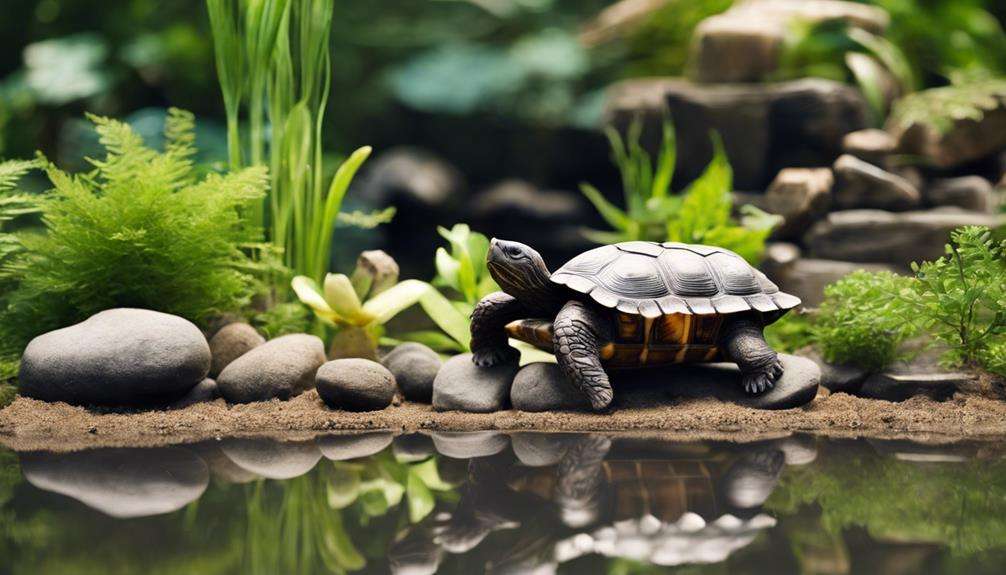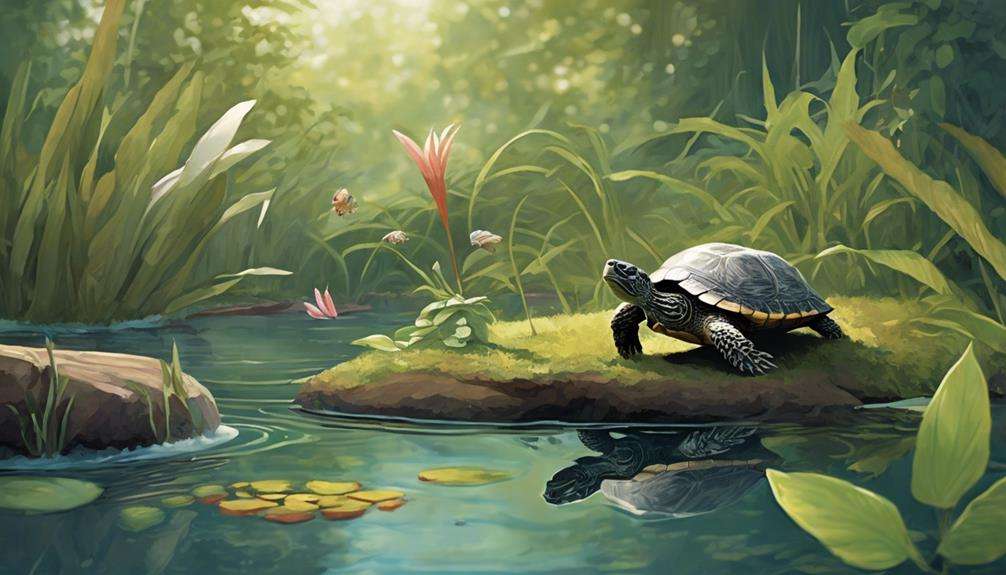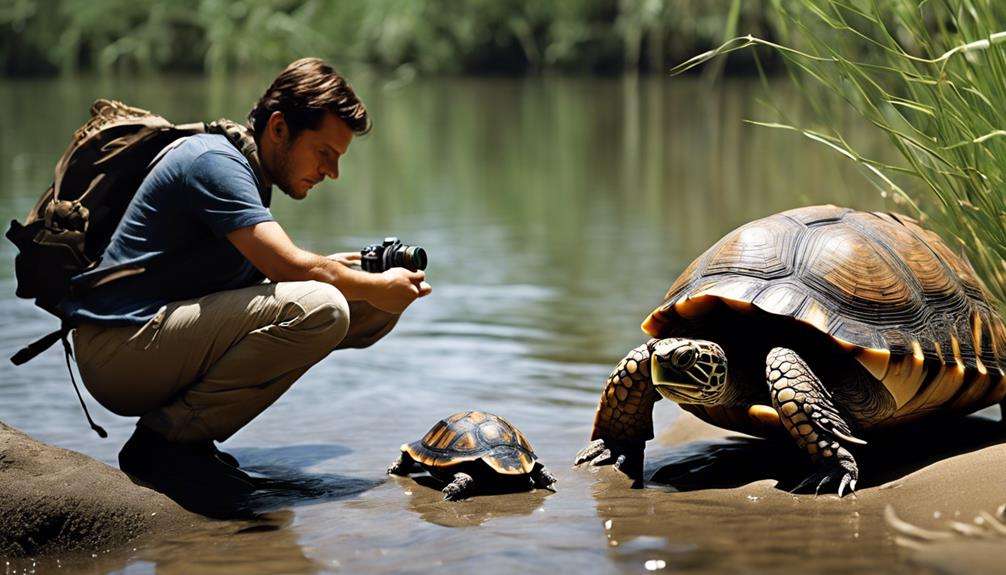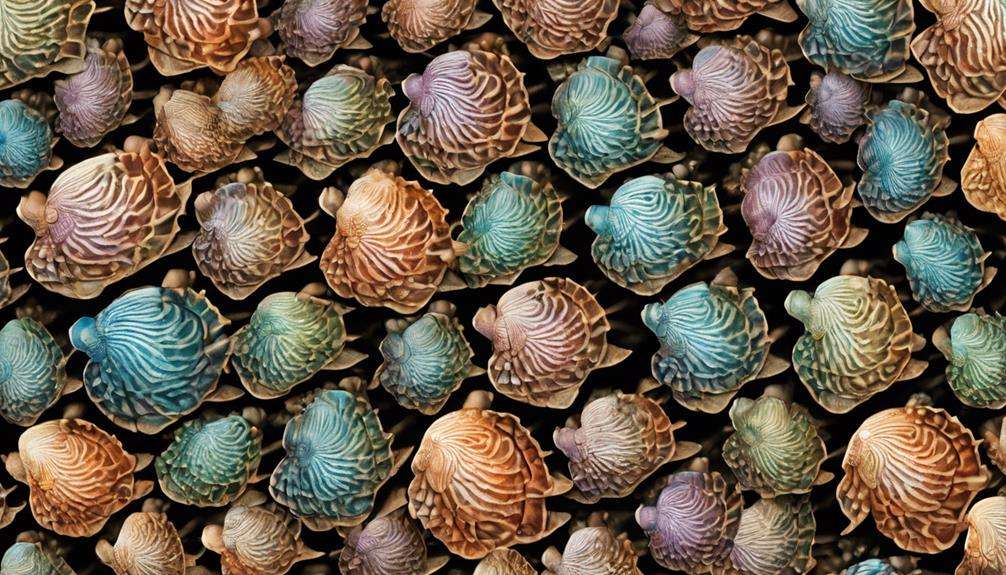Did you know that over half of the world's turtle species are currently endangered? Providing a natural habitat for turtles is not just a necessity but a necessity for their survival. Turtles play an essential role in maintaining the balance of ecosystems, and by creating suitable habitats, you contribute to the preservation of these ancient creatures and the environments they inhabit.
But why stop there? Let's explore the myriad reasons why creating natural habitats for turtles is critical, not only for them but for the entire ecosystem they are a part of.
Key Takeaways
- Natural habitats provide essential shelter, food, and nesting sites for turtles.
- Habitats support biodiversity, ecosystem balance, and genetic diversity crucial for turtle survival.
- Preservation of specific habitats is vital for rare turtle species' long-term viability.
- Mimicking natural environments enhances turtle well-being, health, and natural behaviors.
Benefits of Natural Habitats for Turtles
Creating a natural habitat for turtles not only provides essential shelter and food sources but also safeguards the preservation of breeding grounds crucial for their survival. Various species of sea turtles rely on specific habitats for nesting, feeding, and other critical activities.
For instance, green sea turtles require sandy beaches to lay their eggs, while hawksbill sea turtles thrive in coral reef habitats where they find sponges and algae to feed on. These specialized habitats cater to the diverse ecological needs of different turtle species, offering nesting sites, basking areas, and access to a variety of food sources.
Biodiversity in Turtle Habitats
Diverse plant and animal life thrives within turtle habitats, contributing remarkably to ecosystem balance and resilience. Turtle habitats support a wide range of species, from plants like aquatic vegetation to animals such as fish, insects, and birds. This biodiversity plays an important role in maintaining the health of the ecosystem. Different species interact within the turtle habitat, forming intricate relationships that support essential ecological functions like nutrient cycling and energy flow.
The presence of turtles in these habitats is a sign of a well-functioning ecosystem with adequate resources and environmental conditions. Turtles themselves are an integral part of the biodiversity within these habitats, as they help regulate populations of various species and contribute to the overall balance of the ecosystem. Protecting and creating natural habitats for turtles is crucial not only for the survival of these reptiles but also for preserving overall biodiversity and ensuring the sustainability of interconnected ecosystems. By safeguarding turtle habitats, we can help maintain the intricate web of life that depends on them.
Ecosystem Balance and Turtle Habitats

The intricate interplay between turtle habitats and ecosystem balance is evident in the provision of nesting sites, food sources, and shelter for a myriad of species, illustrating their pivotal role in supporting biodiversity and sustaining overall ecosystem health.
Turtle habitats act as important components in maintaining ecosystem balance by offering safe spaces for nesting, foraging opportunities, and refuge for a wide array of organisms. These habitats support a diverse range of species, including fish, amphibians, and invertebrates, contributing greatly to the richness of biodiversity within an ecosystem.
Turtles, through their interactions with their surroundings, help regulate nutrient cycles, water quality, and habitat connectivity, thereby fostering a healthy and stable environment. By creating and preserving natural habitats for turtles, you actively participate in conserving native plant species, improving soil quality, and enhancing ecological processes that are essential for the well-being of the entire ecosystem.
Your efforts in supporting turtle habitats ultimately promote a balanced and thriving ecosystem where each species plays an important role in the interconnected web of life.
Habitat Preservation for Rare Turtles
To guarantee the survival of rare turtle species, it's imperative to safeguard and restore their specific habitats essential for breeding, nesting, and feeding. Habitat loss poses a grave threat to the existence of rare turtles, as these creatures rely on undisturbed environments to carry out their life cycle. Turtle conservation efforts must focus on preserving the natural habitats that provide these unique species with the necessary resources and conditions for reproduction and sustenance.
Habitat preservation plays a critical role in maintaining the delicate balance required for the survival of rare turtles. Destruction of their habitats through urbanization, pollution, and other human activities has led to a decline in turtle populations worldwide. By conserving these habitats, we not only protect the rare turtles themselves but also contribute to the overall biodiversity and health of ecosystems.
It is essential to prioritize the restoration and protection of habitats crucial for rare turtles to guarantee the long-term viability of their populations. Through targeted conservation initiatives and habitat preservation efforts, we can mitigate the impacts of habitat loss and secure a future for these endangered and unique creatures.
Providing Enrichment in Turtle Habitats

To maintain the health and well-being of your turtles, it's essential to provide enriching elements in their habitat. By creating a stimulating environment that mimics their natural surroundings, you can encourage their natural behaviors and cognitive abilities.
Incorporating varied textures, smells, and activities will contribute to the overall happiness and longevity of your turtles in captivity.
Enrichment for Healthy Turtles
How can you enhance the well-being of your turtles through environmental enrichment in their habitats?
Environmental enrichment in turtle habitats plays an important role in promoting healthy behaviors and overall well-being. By providing diverse vegetation, hiding spots, and basking areas, you can stimulate natural behaviors and reduce stress in your turtles.
Offering various textures, substrates, and objects for exploration not only promotes physical and mental exercise but also encourages natural foraging behaviors. Incorporating challenges such as puzzle feeders and novel items can support cognitive development and prevent boredom.
Enriched habitats mimic natural environments, leading to improved health, enhanced adaptation, and a higher quality of life for your turtles. By prioritizing environmental enrichment, you're investing in the long-term health and happiness of your turtle companions.
Stimulating Turtle Environment
Enhancing the turtle habitat with diverse vegetation, hiding spots, and basking areas promotes natural behaviors and reduces stress in captive turtles. By providing varied textures and opportunities for exploration, you can positively impact the well-being of your turtles.
Enrichment activities such as foraging puzzles and basking platforms offer physical and mental stimulation, mimicking the challenges they'd face in their natural habitat. Incorporating features like plants, rocks, and branches not only encourages natural behaviors but also provides exercise opportunities for your turtles.
Enriching your turtle's environment can prevent boredom, enhance their overall health, and encourage species-specific behaviors. Remember, creating a stimulating environment is vital for captive turtles to thrive, as it closely mirrors the conditions of wild turtles' natural habitats.
Reproduction and Nesting Sites for Turtles
Creating a natural habitat for turtles guarantees the availability of suitable locations for nesting and reproduction, important for the survival of their offspring. Turtles rely on specific environmental conditions to successfully reproduce, making undisturbed natural habitats essential for their reproductive cycles.
Nesting sites within these habitats provide the necessary space for turtles to dig their nests and securely deposit their eggs. Protecting these nesting sites is paramount for maintaining healthy turtle populations and ensuring successful reproduction.
Ensuring Species Survival Through Habitats

To guarantee the survival of turtle species, the creation and maintenance of suitable habitats play a critical role in supporting their genetic diversity and population stability. Natural habitats provide turtles with essential resources like food, shelter, and nesting sites necessary for their survival.
By creating habitats that mimic their natural environments, we can promote natural behaviors and secure the overall well-being of turtle populations. These well-designed habitats not only support the current generations but also contribute to the long-term sustainability of turtle species.
Habitat restoration efforts are particularly vital for the recovery of threatened and endangered turtle species, as they rely heavily on specific habitats for their survival and reproduction. Preserving natural habitats is key to maintaining the delicate balance of turtle populations and the ecosystems they inhabit.
Ensuring the availability of suitable habitats is fundamental in safeguarding the future of turtles and the biodiversity of their habitats.
Health and Well-being in Turtle Habitats
In creating a natural habitat for turtles, it's important to focus on habitat enrichment and reducing environmental stressors.
By providing a habitat that mimics their natural environment, you can enhance their overall well-being and promote their health.
Enriching the turtle's surroundings will encourage natural behaviors and contribute to their physiological and psychological health.
Turtle Habitat Enrichment
Enriching turtle habitats with natural elements such as plants, rocks, and water features is essential for promoting the health and well-being of these reptiles. By mimicking their natural environments, habitat enrichment allows turtles to exhibit their innate behaviors like basking in the sun, foraging for food, and nesting.
The presence of a diverse habitat not only supports their physical health but also reduces stress levels, providing mental stimulation critical for their overall well-being. Incorporating different textures, hiding spots, and climbing opportunities in the habitat encourages exercise and exploration, contributing to a higher quality of life for turtles.
Creating a stimulating and enriched environment is important for ensuring the health and happiness of these fascinating creatures.
Environmental Stress Reduction
The implementation of a natural habitat that reduces environmental stress is essential for enhancing the health and well-being of turtles.
By creating environments that mirror their natural habitats, we can minimize stressors that may impact their species' overall health. Natural habitats offer turtles appropriate shelter, food sources, and the necessary environmental conditions for best growth and development. These settings enable turtles to exhibit their natural behaviors, reducing the risk of stress-related health issues.
Moreover, well-designed natural habitats provide opportunities for exercise, foraging, and social interactions, contributing to the overall well-being of the species. Such habitats enhance turtles' resilience to environmental changes, ultimately improving their quality of life.
Ensuring that turtles are in environments that reduce stress is critical for their long-term health and survival.
Mimicking Natural Environments for Turtles

Crafting a naturalistic environment for turtles involves meticulous attention to detail, ensuring their well-being and natural behaviors are adequately supported in captivity. Mimicking natural environments is essential for the overall health of turtles. By replicating the native wildlife, land, and water elements found in their natural habitats, we can provide a sense of security and comfort for these animals. Creating habitats with appropriate substrates and vegetation not only reduces stress but also encourages behaviors such as basking, foraging, and nesting that are essential for their physical and mental stimulation.
Offering hiding spots, basking areas, and varied terrain in turtle habitats closely resembles their wild surroundings, allowing them to exhibit species-specific behaviors. This replication of their natural environment promotes their overall health and well-being. By providing a natural habitat that mimics their wild homes, we can enhance the quality of life for turtles, stimulate their natural instincts, and support their overall welfare in captivity.
Conservation Impact of Turtle Habitats
Creating and preserving natural habitats for turtles is critical for the conservation of these species. Habitat loss poses a significant threat to turtles, impacting their survival and overall biodiversity.
Habitat Loss Affects Turtles
In the domain of turtle conservation, the consequences of habitat loss loom ominously over their populations, imperiling their survival and reproductive success. Sea turtles, in particular, are greatly impacted by habitat loss as it diminishes their nesting grounds along coastlines.
Destruction of these natural habitats disrupts the delicate balance of ecosystems where sea turtles play a vital role, leading to a decline in their populations. The loss of nesting sites due to habitat degradation results in reduced nesting success, further endangering these magnificent creatures.
Fragmentation of habitats isolates sea turtle populations, constraining their genetic diversity and resilience to environmental changes. Creating and preserving natural habitats for sea turtles is paramount for their long-term conservation and overall well-being.
Biodiversity Relies on Habitats
Preserving turtle habitats is essential for maintaining biodiversity and ensuring the survival of various plant and animal species. Turtle habitats play an important role in supporting a diverse range of organisms, contributing to the overall health of ecosystems.
Conservation efforts focused on protecting turtle habitats are critical for sustaining balanced environments and promoting the interconnected web of life. By safeguarding these habitats, conservationists help preserve the intricate relationships among species and maintain essential ecological processes.
Loss or degradation of turtle habitats can have far-reaching consequences, leading to disruptions in food chains and impacting the populations of other species. Creating and preserving natural habitats for turtles is fundamental for supporting biodiversity and advancing conservation efforts in the broader context of ecosystem health.
Protecting Habitats Saves Species
Protecting turtle habitats is an important strategy in safeguarding endangered species and maintaining biodiversity within ecosystems. Preserving these habitats is vital for the conservation of box turtles, a species facing habitat destruction and fragmentation.
By ensuring the preservation of their natural environments, we can help mitigate the threats that endanger these vulnerable species. Endangered species like the bog turtle, listed under the Endangered Species Act, rely on well-preserved habitats for their survival.
Additionally, the conservation of turtle habitats contributes to the protection of all seven sea turtle species, which are safeguarded under the ESA and CITES. Through the protection of these habitats, we play a significant role in saving species from extinction and promoting overall ecosystem health.
Frequently Asked Questions
What Is the Importance of Turtles to the Environment?
Turtles play an important role in maintaining ecosystem balance and biodiversity preservation. They contribute to controlling prey populations, supporting vegetation through nesting, and benefiting various species. Their presence is essential for healthy marine environments.
What Is Turtles Natural Habitat?
Turtles thrive in diverse ecosystems from freshwater bodies to terrestrial landscapes. They seek shelter in burrows or bask under the sun for warmth. Protecting their natural habitats is essential for conservation efforts and ensuring their well-being.
What Makes a Good Turtle Habitat?
In a good turtle habitat, water temperature stability and varied shelter options are crucial. Vegetation and basking spots support their needs. Guarantee sandy nesting areas, basking sites like logs, native plants, and clean water sources for a diverse and thriving turtle environment.
What Do Turtles Need to Survive in Their Habitat?
To survive in their habitat, turtles need diverse food sources like plants and insects for nutrition. They require shelter such as rocks and vegetation for security. Clean water with proper temperature is crucial for swimming and maintaining body functions.
Conclusion
As you gaze upon the lush greenery and sparkling waters of a natural turtle habitat, envision the intricate web of life that thrives within. By creating and preserving these habitats, you aren't only ensuring the survival of turtles but also nurturing a crucial ecosystem where each species plays a significant role.
Your dedication to conservation efforts will ripple through generations, safeguarding these remarkable creatures for years to come. Embrace the beauty of nature and protect the turtles that call it home.






